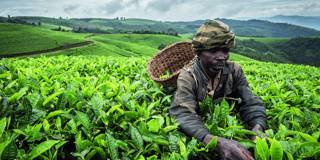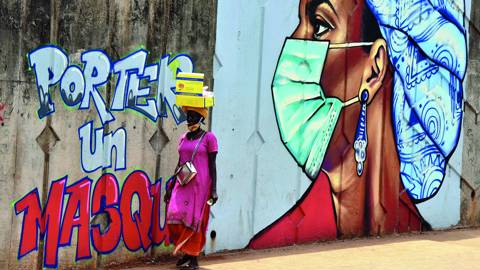After the devastating blow that COVID-19 dealt to low- and middle-income countries, the economic fallout from Russia's war in Ukraine has compounded the damage by driving up the prices of key commodities. Building more resilience and sustainability into the world's food systems has never been more urgent.
NAIROBI – In recent years, successive shocks have undermined global food security, reversing decades of progress. COVID-19, for example, pushed 70-100 million people into extreme poverty and 118 million more into food insecurity (defined as a “lack of regular access to enough safe and nutritious food for normal growth and development and an active and healthy life”). In East Africa, the worst locust swarms in 70 years deepened food insecurity in a region that was already struggling with significant drought. And now, Russia’s war in Ukraine has further exposed fragilities in the world’s food systems.
At a time when food prices were already rising, the conflict has curtailed supplies of wheat, vegetable oil, and fertilizer from throughout the Black Sea region. Each of these commodities bears directly on global food security and nutrition outcomes. The Center for Global Development estimates that higher food and fuel prices will push 40 million more people into extreme poverty and hunger, mainly in Africa. Hundreds of millions more will suffer hardship.
These shocks have sent a clear message: We must fundamentally transform our food systems to make them more resilient. Worsening global conditions have also amplified many of the challenges discussed at the UN Food Systems Summit that Secretary-General António Guterres hosted last fall. As we noted then, the world is far behind in achieving the UN Sustainable Development Goals (SDGs). Our food systems, which should be a source of solutions, are a big part of the problem.
Last year’s summit was the culmination of an inclusive two-year consultation process in which governments and communities discussed how food systems could be improved to bring the SDGs within reach. As of today, more than 110 countries have adopted policy roadmaps for transforming their food systems, committing to measures that will strengthen resilience while feeding their people, bolstering livelihoods, and protecting the planet.
Owing to this work, today’s food, fertilizer, and financing crises can be tackled through commitments that we have already made. But meeting those commitments will require some new thinking. Three ideas stand out for me.
First, countries must promote food diversification and reduce their overreliance on commodities like wheat. In West Africa, cassava is easy to grow and can substitute for wheat in bread (as is already happening in Nigeria). All agro-ecological zones have such comparative advantages, and harnessing them would enable countries and communities to mitigate current shocks and respond to the threat of climate change.
Moreover, diversification can shorten supply chains and increase sustainable food production, which reduces dependence on single sources of vital foodstuffs, not to mention lowering import bills. It is also important for nutrition and the conservation or recovery of biodiversity in agricultural zones.
Second, we need to devise more innovative ways to ensure that farmers can access the nutrients, fertilizers, and inputs they need to produce enough food. Experience shows that cutting back on fertilizers and agrochemicals is key to finding a new balance with nature. This imperative is especially relevant in parts of the world where excess inputs serve only profits, rather than food security. Necessary reductions can be achieved by eliminating subsidies that incentivize overuse.
In Africa, where eroded soils, poor productivity, and high pest pressure contribute to low yields, environmental degradation – especially deforestation – tends to accelerate as farmers seek new fertile land. The solutions to this problem must be found locally, in the form of more creative and innovative uses of nutrients, fertilizers, and agrochemicals. In western Kenya, working with the Global Environment Facility and the UN Environment Programme, my organization has helped farmers rehabilitate 6,000 hectares of degraded forests by encouraging sustainable farming techniques. These approaches can be replicated globally through collaboration between governments, researchers, and the private sector.
Lastly, today’s heightened supply risks may tempt some countries to consider protectionism, so we must remember that we are interdependent and therefore stronger together. Efficient, equitable trade makes everyone more resilient. But to capture more of the benefits of trade in Africa, we must do more to help local communities access markets. That means supporting the African Continental Free Trade Area, so that our intra-regional trade, which now accounts for less than 20% of Africa’s total trade, rises to the much higher levels found on other continents.
How can we best pursue these ideas? While rethinking how they regulate food systems, governments must also encourage more private-sector investment, and political leaders must elevate food-system reform to a higher place on the global development agenda. The coming months will offer numerous opportunities to do so. While the UN has launched a Global Crisis Response Group to focus on the food, energy, and fertilizer price spikes, Germany is using its G7 presidency to push for an “alliance for global food security.” Food systems will also be a major issue at the African Union’s summit this July (where the theme is “2022: The Year of Nutrition”), and at the COP27 climate-change conference in Egypt this November.
The next steps to tackle the food-price crisis are clear. Governments should mobilize resources to help the most vulnerable countries, and to build more resilient food systems. And rich countries must do more to reduce greenhouse-gas emissions and help low- and middle-income countries adapt to climate change, which is already making life much more difficult for farmers around the world.
We have eight harvests to go until 2030 – the deadline year for meeting the SDGs and preventing irreversible damage from climate change. The Food Systems Summit generated a wealth of new ideas, as well as reform commitments from 166 countries. Thousands of stakeholders agreed that transforming our food systems cannot wait. Humans are smart, creative, and innovative. We have the means to live sustainably within nature’s boundaries, while still improving the lives of billions of people around the world. But whether we have the necessary humility remains to be seen.






NAIROBI – In recent years, successive shocks have undermined global food security, reversing decades of progress. COVID-19, for example, pushed 70-100 million people into extreme poverty and 118 million more into food insecurity (defined as a “lack of regular access to enough safe and nutritious food for normal growth and development and an active and healthy life”). In East Africa, the worst locust swarms in 70 years deepened food insecurity in a region that was already struggling with significant drought. And now, Russia’s war in Ukraine has further exposed fragilities in the world’s food systems.
At a time when food prices were already rising, the conflict has curtailed supplies of wheat, vegetable oil, and fertilizer from throughout the Black Sea region. Each of these commodities bears directly on global food security and nutrition outcomes. The Center for Global Development estimates that higher food and fuel prices will push 40 million more people into extreme poverty and hunger, mainly in Africa. Hundreds of millions more will suffer hardship.
These shocks have sent a clear message: We must fundamentally transform our food systems to make them more resilient. Worsening global conditions have also amplified many of the challenges discussed at the UN Food Systems Summit that Secretary-General António Guterres hosted last fall. As we noted then, the world is far behind in achieving the UN Sustainable Development Goals (SDGs). Our food systems, which should be a source of solutions, are a big part of the problem.
Last year’s summit was the culmination of an inclusive two-year consultation process in which governments and communities discussed how food systems could be improved to bring the SDGs within reach. As of today, more than 110 countries have adopted policy roadmaps for transforming their food systems, committing to measures that will strengthen resilience while feeding their people, bolstering livelihoods, and protecting the planet.
Owing to this work, today’s food, fertilizer, and financing crises can be tackled through commitments that we have already made. But meeting those commitments will require some new thinking. Three ideas stand out for me.
First, countries must promote food diversification and reduce their overreliance on commodities like wheat. In West Africa, cassava is easy to grow and can substitute for wheat in bread (as is already happening in Nigeria). All agro-ecological zones have such comparative advantages, and harnessing them would enable countries and communities to mitigate current shocks and respond to the threat of climate change.
SPRING SALE: Save 40% on all new Digital or Digital Plus subscriptions
Subscribe now to gain greater access to Project Syndicate – including every commentary and our entire On Point suite of subscriber-exclusive content – starting at just $49.99.
Subscribe Now
Moreover, diversification can shorten supply chains and increase sustainable food production, which reduces dependence on single sources of vital foodstuffs, not to mention lowering import bills. It is also important for nutrition and the conservation or recovery of biodiversity in agricultural zones.
Second, we need to devise more innovative ways to ensure that farmers can access the nutrients, fertilizers, and inputs they need to produce enough food. Experience shows that cutting back on fertilizers and agrochemicals is key to finding a new balance with nature. This imperative is especially relevant in parts of the world where excess inputs serve only profits, rather than food security. Necessary reductions can be achieved by eliminating subsidies that incentivize overuse.
In Africa, where eroded soils, poor productivity, and high pest pressure contribute to low yields, environmental degradation – especially deforestation – tends to accelerate as farmers seek new fertile land. The solutions to this problem must be found locally, in the form of more creative and innovative uses of nutrients, fertilizers, and agrochemicals. In western Kenya, working with the Global Environment Facility and the UN Environment Programme, my organization has helped farmers rehabilitate 6,000 hectares of degraded forests by encouraging sustainable farming techniques. These approaches can be replicated globally through collaboration between governments, researchers, and the private sector.
Lastly, today’s heightened supply risks may tempt some countries to consider protectionism, so we must remember that we are interdependent and therefore stronger together. Efficient, equitable trade makes everyone more resilient. But to capture more of the benefits of trade in Africa, we must do more to help local communities access markets. That means supporting the African Continental Free Trade Area, so that our intra-regional trade, which now accounts for less than 20% of Africa’s total trade, rises to the much higher levels found on other continents.
How can we best pursue these ideas? While rethinking how they regulate food systems, governments must also encourage more private-sector investment, and political leaders must elevate food-system reform to a higher place on the global development agenda. The coming months will offer numerous opportunities to do so. While the UN has launched a Global Crisis Response Group to focus on the food, energy, and fertilizer price spikes, Germany is using its G7 presidency to push for an “alliance for global food security.” Food systems will also be a major issue at the African Union’s summit this July (where the theme is “2022: The Year of Nutrition”), and at the COP27 climate-change conference in Egypt this November.
The next steps to tackle the food-price crisis are clear. Governments should mobilize resources to help the most vulnerable countries, and to build more resilient food systems. And rich countries must do more to reduce greenhouse-gas emissions and help low- and middle-income countries adapt to climate change, which is already making life much more difficult for farmers around the world.
We have eight harvests to go until 2030 – the deadline year for meeting the SDGs and preventing irreversible damage from climate change. The Food Systems Summit generated a wealth of new ideas, as well as reform commitments from 166 countries. Thousands of stakeholders agreed that transforming our food systems cannot wait. Humans are smart, creative, and innovative. We have the means to live sustainably within nature’s boundaries, while still improving the lives of billions of people around the world. But whether we have the necessary humility remains to be seen.